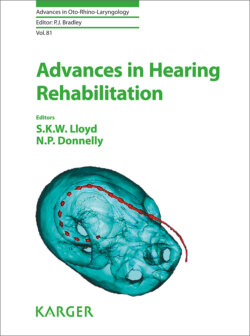Читать книгу Advances in Hearing Rehabilitation - Группа авторов - Страница 37
На сайте Литреса книга снята с продажи.
Mechanical Properties of the Implant
ОглавлениеThe mechanical properties of the implant probably only have a minor effect on the transmission of vibrations, provided they meet some minimum criteria outlined below.
Rigidity: The implant has to be more rigid than the structures it is driving, otherwise the forces exerted on it will lead to bending and losses in its compliance rather than in delivering the force to the target. Compliances are likely to particularly affect the higher frequencies. In practice, almost all commercially available and autologous implants are rigid enough. In cadaveric tests in our lab, all materials from plastics, bone, wood and metals seem equivalent. For low frequencies, even viscous ointment-like connections seem to deliver reasonable results (unpublished observations).
Mass: The middle ear is dominated by stiffness in low frequencies, and mass has little effect here. Of course, if the mass is very large, the frequencies at which it will have an effect become lower and lower. Experience with reconstruction using the whole incus (mass about 30 mg) shows that even this large mass is acceptable. In cadaveric experiments, we loaded masses up to 55 mg onto a SHOT type prosthesis and found only a small, about 5 dB, reduction in stapes velocity above 4 kHz [13] (Fig. 2). Others have found similar small effects from loading masses onto the natural ossicles [14].
Another reason for desiring low mass is the stability of the prosthesis in response to high acceleration forces, such as head trauma. The inertia of heavier prostheses may displace them more than light ones. In unpublished observations, we have found that light titanium prostheses do not displace even up to 5–7 g accelerations. Titanium is desirable in having high rigidity with low mass, but is difficult to shape easily.
Prosthesis Head Size: Because the TM breaks up into smaller vibrating units at higher frequencies, the head size of the prosthesis has to be large enough that it does not just sample a single node on the TM, which may have resonances of its own. The malleus to some extent does this naturally by averaging over the whole TM. Beyond this, large prosthesis head sizes will sample more of the TM, but will also stiffen the TM and may change its impedance matching to air. We compared [15] SHOT prosthesis head sizes of 4 × 4, 4 × 3 and 3 × 2 mm in temporal bones with little difference found in the stapes responses (Fig. 2). These sizes encompass most of the sizes of commercial prostheses. There is little need to use a large head size, which is more difficult to place, when a smaller head size is easier to work with.
Fig. 2. Summary of effects of different parameter changes on vibration transmission to the stapes, based on our work on (a) increased prosthesis tension which affects the lower frequencies greatly, (b) increased mass which affects the higher frequencies modestly, (c) reconstruction to the malleus versus reconstruction to the TM which improves the lower frequencies modestly, (d) interface between the prosthesis and the TM adding a compliance can affect higher frequencies, (e) prosthesis head size and (f) cartilage thickness between the prosthesis and TM (unpublished data), both of which have little effect.
